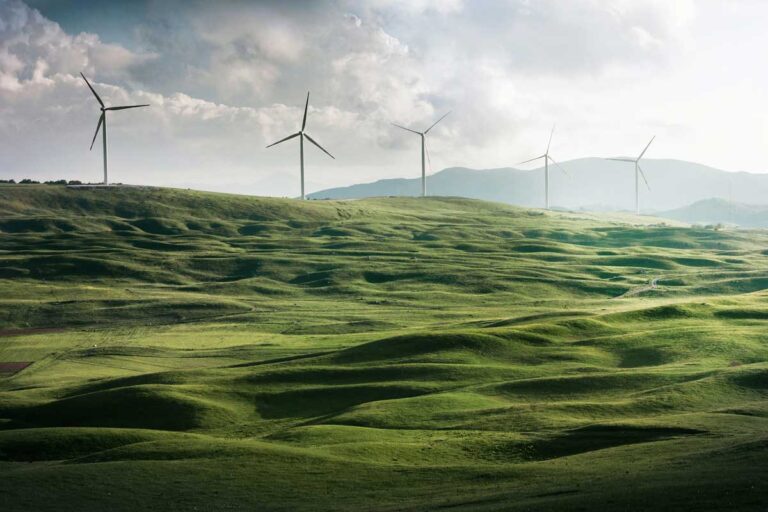Only public-private co-operation can accelerate decarbonisation

As countries around the world experienced record temperatures last year, UN Secretary-General Antonio Guterres declared: “We must turn a year of burning heat into a year of burning ambition.” But to move away from fossil fuels and unlock the green transition’s economic benefits, such as job creation and universal access to clean energy, industry leaders and policymakers must work together to translate the commitments made at the UN Climate Change Conference in Dubai (COP28) into actual renewable gigawatts.
COP28 marked a historic turning point in the battle against climate change. Rallying around the UAE Consensus, world leaders pledged to move away from fossil fuels, agreeing to triple renewable power capacity to at least 11,000 gigawatts and double energy efficiency by 2030.
But ambition alone is not enough to achieve these targets and limit global warming to 1.5C. Governments must invest in mature, cost-competitive renewable technologies that can be rapidly deployed at scale. When integrated with long-duration energy storage, green hydrogen, and system optimisation, these technologies represent the most reliable and flexible way to accelerate the energy transition.
Renewables will undoubtedly shape the global energy landscape in the coming years. Both solar and wind power are expected to grow significantly, with hydropower serving as the backbone of grid flexibility. Consequently, renewables are poised to become the twenty-first century’s dominant source of global electricity.
But as a joint report released by the International Renewable Energy Agency (IRENA) and the Global Renewables Alliance (GRA) ahead of COP28 noted, tripling renewable capacity will require cooperation between the private and public sectors. Partnerships should focus on initiatives that deliver immediate results, such as mobilising low-cost financing, accelerating permitting processes, clearing grid connection backlogs, reforming government auction mechanisms for renewable-energy projects, and diversifying global supply chains. A strong commitment to inclusivity and the active participation of developing economies must be at the heart of these efforts. IRENA and GRA are demonstrating this commitment by collaborating on the annual reports commissioned by the COP28 Presidency to monitor progress toward the global tripling target and facilitate the energy transition.
We must, however, move faster, especially if we aim to ensure that progress is equitably distributed around the world. While renewable power capacity rose by 473 gigawatts in 2023, the economic benefits of the energy transition did not reach every country. Remarkably, 83% of these increases were concentrated in China, the European Union, and the US, leaving many countries in the Global South behind.
In fact, the shift to renewables is alarmingly slow in many parts of the world. Opportunities to address development and access challenges in Sub-Saharan Africa, where more than 500mn people still lack access to electricity, are being squandered. This sluggish transition can be attributed largely to the lack of affordable financing, adequate planning, and the policy and market frameworks needed to support the adoption of renewable energy. Tellingly, public fossil-fuel subsidies reached $1.3tn in 2022 – roughly the annual investment needed to triple renewable capacity by 2030.
A critical first step toward fostering greater public-private co-operation in pursuit of COP28’s ambitious targets is to reform the global financial architecture. Africa, for example, accounts for 17% of the world’s population but has received less than 2% of global investments in renewable energy over the past two decades, underscoring the need to reduce capital costs and attract private investors. Developing industrial clusters and initiating grant programs could also help foster environments conducive to innovation and private-public partnerships.
Recent commitments by world leaders offer glimmers of hope. African leaders at the September 2023 Africa Climate Summit in Nairobi, for example, pledged to increase the continent’s renewable capacity to at least 300 gigawatts by 2030. This effort aims to reduce energy poverty and boost the global supply of cost-effective clean energy suitable for industrial use.
Kenyan President William Ruto, a key advocate of the Nairobi agreement, established the Accelerated Partnership for Renewables in Africa, an African-led international alliance of governments and stakeholders that aims to accelerate renewable-energy deployment, increase access, promote green industrialisation, and strengthen economic and societal resilience.
Governments and business leaders should harness the current political momentum to foster co-operation between policymakers and private investors. As governments develop appropriate policy and market frameworks to facilitate the transition to renewables, the private sector – historically responsible for 86% of global investments in renewable energy – is poised to lead the charge. Together, we can achieve a clean, secure, and just energy future. But to realise this vision, we must act fast. – Project Syndicate
- Francesco La Camera is Director-General of the International Renewable Energy Agency. Bruce Douglas is CEO of the Global Renewables Alliance.











CAMBRIDGE – The recent passing of psychologist and Nobel laureate Daniel Kahneman is an apt moment to reflect on his invaluable contribution to the field of behavioral economics. While Alexander Pope’s famous assertion that “to err is human” dates back to 1711, it was the pioneering work of Kahneman and his late co-author and friend Amos Tversky in the 1970s and early 1980s that finally persuaded economists to recognize that people often make mistakes.
When I received a fellowship at Stanford University’s Center for Advanced Study in the Behavioral Sciences (CASBS) four years ago, it was this fundamental breakthrough that motivated me to choose the office – or “study” (to use CASBS terminology) – that Kahneman occupied during his year at the Center in 1977-78. It seemed like the ideal setting to explore Kahneman’s three major economic contributions, which challenged economic theory’s apocryphal “rational actor” by introducing an element of psychological realism into the discipline.
Kahneman’s first major contribution was his and Tversky’s groundbreaking 1974 study on judgment and uncertainty, which introduced the idea that “biases” and “heuristics,” or rules of thumb, influence our decision-making. Instead of thoroughly analyzing each decision, they found, people tend to rely on mental shortcuts. For example, we may rely on stereotypes (known as the “representativeness heuristic”), be overly influenced by recent experiences (the “availability heuristic”), or use the first piece of information we receive as a reference point (the “anchor effect”).
Second, Kahneman and Tversky’s work on “prospect theory,” which they published in 1979, critiqued expected utility theory as a model of decision-making under risk. Drawing on the “certainty effect,” Kahneman and Tversky argued that humans are psychologically more affected by losses than gains. The perceived loss from misplacing a $20 note, for example, would outweigh the perceived gain from finding a $20 note on the sidewalk, leading to “loss aversion.”
This insight is also at the core of the “framing effect.” The theory, developed while Kahneman was a fellow at CASBS and Tversky was a visiting professor at Stanford, posits that the way information is presented – whether as a loss or a gain – significantly influences the decision-making process, even when what is framed as a loss or gain has the same value.
Lastly, there is Kahneman’s popular masterpiece, the bestselling Thinking, Fast and Slow. Published in 2011 and offering a lifetime’s worth of insights, the book introduced the general public to two stylized modes of human decision-making: the “quick,” instinctive, emotional mode that Kahneman called System 1, and the “slower,” deliberative, or logical mode, which he called System 2. Humans, he showed, are prone to abandoning logic in favor of emotional impulses.
Kahneman received the Nobel Prize in Economics in 2002, despite, as he jokingly remarked, having never taken a single economics course. Nevertheless, his scholarship laid the groundwork for an entirely new field of economic research – and it had all begun in Study 6.
In particular, Kahneman’s work had a profound impact on University of Chicago economist Richard Thaler, who went on to become a Nobel laureate himself. As an assistant professor, Thaler managed to “finagle” a visiting appointment at the National Bureau of Economic Research, whose offices were located down the hill from CASBS, enabling him to connect with Kahneman and Tversky.
In 1998, Thaler co-authored a seminal paper with Cass Sunstein and Christine Jolls, introducing the concept of “bounds” on reason, willpower, and self-interest, and highlighting human limitations that rational-actor models had overlooked. By the time he received the Nobel Prize in 2017, Thaler had systematically documented “anomalies” in human behavior that conventional economics struggled to explain and conducted highly influential research (with Sunstein) on “choice architectures,” popularizing the idea that subtle design changes (“nudges”) can influence human behavior.
But as I gazed at the sweeping views of Palo Alto and the San Francisco Peninsula from the office window at CASBS, the birthplace of behavioral economics, I could not help but wonder whether Kahneman, despite his famously gentle nature, had perhaps been too critical of human decision-making. Are all deviations from “pure” economic logic necessarily “irrational”? Is our inability to align with the idealized model of economic analysis, coupled with our inevitable – albeit predictable – irrationality, really an inherent weakness? And is our tendency to rely on emotions rather than reason a fatal flaw, and if so, could our susceptibility to instinct ultimately lead to our downfall?
I wish I could ask Kahneman these questions. During my time there in 2020-21, Kahneman, affectionately known as “Danny” to all, was not just what CASBS called a “ghost” of the “study” – a former occupant who had been a major influence on my work – but also, happily, a vibrant, living legend who had enthusiastically invited me to discuss these very issues in person. Looking back, I regret my “planning fallacy” in not taking him up on his offer to deepen our conversation sooner – a sentiment shared by both my System 1 and System 2 modes. If “to err is human,” Danny taught me a poignant final lesson in human error.